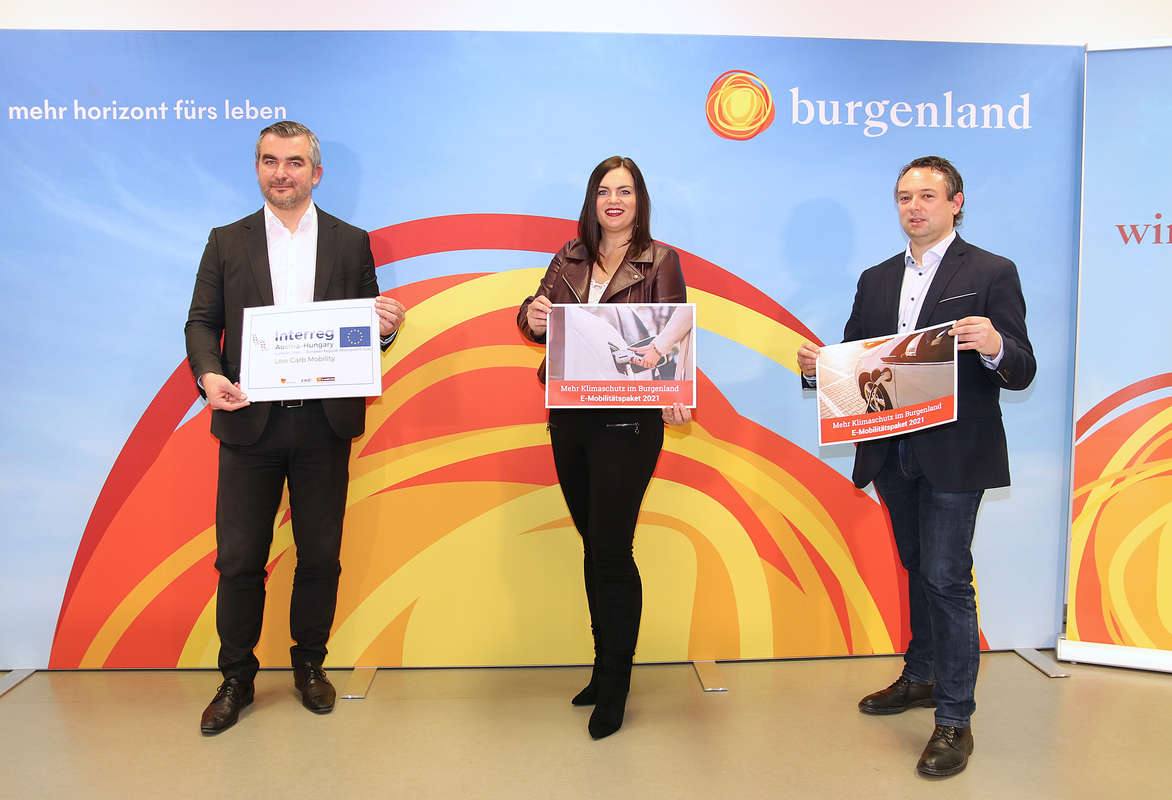STATE RAISES CLIMATE PROTECTION STAKES - E-MOBILITY PACKAGE AND CHARGING INFRASTRUCTURE FUNDING FOR 2021
Provincial Deputy Governor Astrid Eisenkopf and Provincial Councilor Heinrich Dorner presented on 17. 12. 2020 a new funding package for climate and environmental protection. This provides for the doubling of the e-car and e-motorcycle purchase subsidy from a maximum of 1,000 to 2,000 euros, as well as the subsidization of private e-charging stations in the future. In addition, the special subsidy for the replacement of oil heating systems launched in 2019 will be extended to the replacement of old gas heating systems, all-burner stoves, electricity night storage and direct electricity heating systems, and the subsidy will be increased from a maximum of 3,000 to 3,500 euros.
Positive incentives
With the goal of becoming climate-neutral by 2050, the Burgenland state government has adopted a climate and energy strategy. Key points are the expansion of wind power and photovoltaics, more climate-friendly mobility, improving the energy efficiency of buildings and expanding climate-friendly agriculture. However, climate protection must be designed to be socially acceptable and fair, Eisenkopf emphasized. "However, we don't want a prescriptive policy, we want to take people along with us. That's why we rely on positive incentives. With its subsidies, the Burgenland Eco-energy Fund has proven to be an important instrument for pushing climate protection in the private sector. This is the only way we can succeed in the energy transition," the climate protection officer is convinced. The corona pandemic, which has resulted in a lower environmental impact in the short term due to the lockdowns, is "a tremendous opportunity to learn how we can support nature in a sustainable way."
Smart, balanced mix of measures
In addition to expanding public transportation, Dorner wants to focus primarily on initiatives in the area of e-mobility. The strategy for this, he said, is also laid down in the plan for the future of Burgenland. "What we need in Burgenland is a smart, balanced mix of measures that includes all forms of mobility - individual transport, public transport, bicycles, walking - and that takes into account the rural structure. And it also needs appropriate awareness raising." Many Burgenlanders would continue to rely on their cars in the future. "Here we want to create increased incentives for a switch to alternative forms of propulsion."
"Out of oil" becomes "Out of fossil".
The "Get out of oil" initiative launched in 2019, which promotes the switch from oil heating to sustainable heating systems, will be expanded to include the replacement of old gas heating systems, all-burner stoves, as well as electricity night storage and direct current heating systems. The previous maximum subsidy will be increased from 3,000 to 3,500 euros. Eisenkopf: "This means that we not only want to move away from oil boilers, but away from fossil fuels in general."
E-car subsidy to be doubled to 2,000 euros
"We also want to significantly increase the number of e-cars and e-motorcycles in Burgenland," Eisenkopf announced. This is to be achieved by doubling the purchase subsidy for e-cars from a maximum of 1,000 to a maximum of 2,000 euros. A novelty is that the subsidy applies not only to new, but also to used e-cars and e-motorcycles up to a maximum of 24 months from initial registration and a maximum mileage of 20,000 km. "With this increase, we are currently the state with the best subsidy for e-vehicles," Eisenkopf said.
150 euros for e-bike purchase from Burgenland dealer
A smart mix must also include cycling, Dorner is convinced. Currently, work is being done on expanding a basic bicycle network in all districts. And, above all, one is also counting on the e-bike boom. Due to the great success - in 2020 there were 1,809 applications with a funding amount of 320,000 euros - the e-bike funding campaign is to be continued in the coming year. The subsidy amount of a maximum of 150 euros per e-bike when purchased from a dealer in Burgenland will be maintained.
Key factor charging infrastructure - up to 500 euros for private charging station
The success of e-mobility depends not least on the charging infrastructure. That's why there will be subsidies of up to 500 euros for privately built wallboxes and charging columns, depending on their performance. He said there is already one public e-charging station per district; in the coming years, e-charging points are to be built at all provincial filling stations and all park & ride facilities. "By the end of 2021, we will also set up charging stations at the larger housing complexes and nursing homes," Dorner outlines the further roadmap.
Burgenland to be e-car pioneer by 2030
The share of e-cars in Burgenland is to be increased significantly. According to a recent mobility survey, around 13% of respondents want to buy an e-car in the next five years. In addition to the still lower range, the high purchase costs were named as the main hurdle. The doubling of e-car subsidies is expected to give new impetus to sales. There was great feedback recently on the "I foa E-Auto" project, in which 250 people were able to test an e-car for three days free of charge.
Eco-energy fund success model: 34.5 million euros in funding since 2013
In total, around 2.4 million euros in climate subsidies were paid out from the Eco Energy Fund in 2020, including 1.1 million euros for alternative energy systems, 630,000 euros for oil heating system replacements, 200,000 euros for photovoltaic systems, 122,000 euros for the special subsidy for photovoltaics in combination with a heat pump and 320,000 euros for alternative mobility. In total, around 34.5 million euros have been funded since 2013, resulting in more than 23,000 funding applications. In 2021, 3.4 million euros will be available from the Eco-energy Fund. "Not only does the environment benefit from the subsidies from the Eco Energy Fund, but also the domestic economy," Eisenkopf explained.




